To conduct UAV search and rescue missions, you'll need specialized equipment, including drones with thermal imaging and high-resolution cameras. Start by defining your search area and creating detailed flight plans. Guarantee you comply with local regulations and obtain necessary airspace authorizations. Assess weather conditions carefully, as they can impact your drone's performance. Coordinate closely with ground teams and establish clear communication protocols. Master precision flying techniques and grid search patterns for thorough coverage. After the mission, analyze collected data using specialized software to identify potential survivors. Proper planning, execution, and post-mission analysis are essential for successful UAV-assisted search and rescue operations. The following sections will equip you with in-depth knowledge to enhance your mission effectiveness.
Understanding UAV Search and Rescue
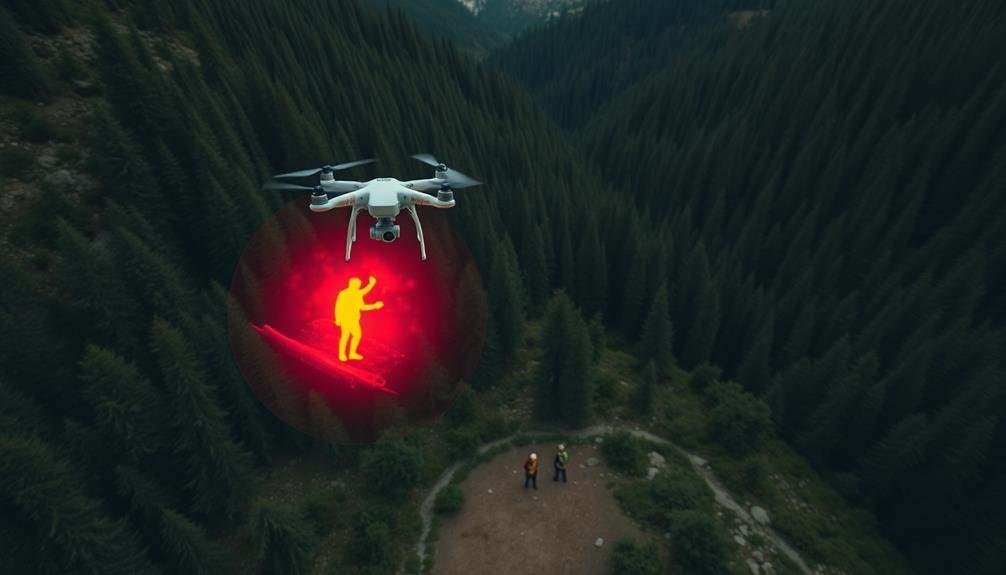
In light of advancing technology, UAV search and rescue missions have become increasingly important in emergency response efforts. UAVs, or unmanned aerial vehicles, offer unique advantages in search and rescue operations, including the ability to cover large areas quickly and access hard-to-reach locations.
To understand UAV search and rescue, you'll need to familiarize yourself with the types of drones used, their capabilities, and the specific roles they play in rescue missions. Fixed-wing and multirotor drones are commonly employed, each with distinct strengths. Fixed-wing drones excel at long-range missions, while multirotor drones offer superior maneuverability in confined spaces.
You'll also need to grasp the various sensors and payloads used in these missions, such as high-resolution cameras, thermal imaging devices, and LiDAR systems. These tools enable you to detect heat signatures, identify objects, and create detailed 3D maps of search areas.
Understanding the legal and regulatory framework surrounding UAV operations is vital. You must comply with local and national regulations, including airspace restrictions and privacy laws. Proper training and certification are essential to guarantee safe and effective UAV search and rescue operations.
Essential Equipment and Tools
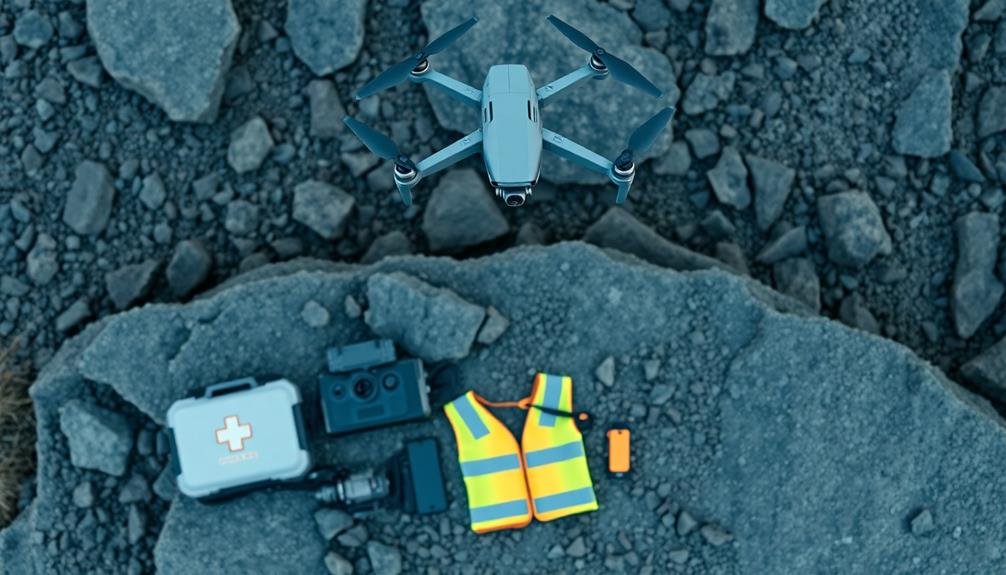
When conducting UAV search and rescue missions, you'll need to choose the right drone types and features for your specific needs.
Your UAV should have capabilities like thermal imaging, high-resolution cameras, and long flight times to maximize search efficiency.
Additionally, you must equip your operation with reliable communication and navigation systems to maintain contact with your team and guide the drone effectively.
Drone Types and Features
Choosing the right drone for search and rescue missions is vital for success. You'll need to evaluate several types of drones and their features to guarantee you're equipped for various scenarios.
Fixed-wing drones offer longer flight times and greater range, making them ideal for covering large areas quickly. Multirotor drones, on the other hand, provide better maneuverability and the ability to hover, which is essential for detailed inspections and precise locations.
Look for drones with high-resolution cameras and thermal imaging capabilities. These features allow you to spot heat signatures and identify potential survivors in challenging conditions. GPS functionality is necessary for accurate positioning and mission planning.
Obstacle avoidance systems help prevent crashes in complex environments. Examine drones with long battery life or the ability to swap batteries quickly to minimize downtime. Weather resistance is also important, as search and rescue operations often occur in harsh conditions.
Some advanced drones offer autonomous flight modes, which can be useful for pre-programmed search patterns. Finally, verify your chosen drone has a reliable communication system with a sufficient range to maintain control throughout the mission.
Communication and Navigation Systems
Effective communication and navigation systems form the backbone of successful UAV search and rescue missions. You'll need reliable equipment to maintain contact with your ground team and accurately navigate your drone. Invest in a high-quality radio system that allows clear, long-range communication between operators and support personnel.
Confirm your UAV is equipped with a robust GPS module for precise positioning and waypoint navigation.
For enhanced situational awareness, consider integrating a first-person view (FPV) system. This allows you to see real-time video feed from the drone's perspective, helping you navigate challenging terrains and identify potential search targets more effectively.
Key components of your communication and navigation setup should include:
- Long-range telemetry system for transmitting flight data
- Obstacle avoidance sensors to prevent collisions in complex environments
- Automated return-to-home function for emergencies
Remember to test your systems thoroughly before each mission. Familiarize yourself with their operation and limitations.
In search and rescue scenarios, reliable communication and navigation can mean the difference between success and failure. Always have backup systems and spare batteries on hand to confirm uninterrupted operation during critical missions.
Flight Planning and Preparation
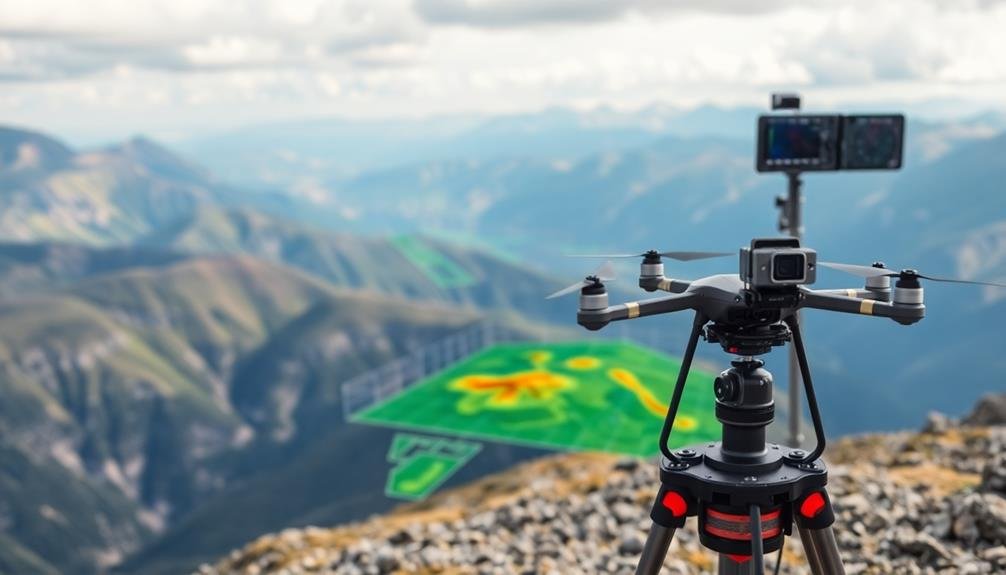
Meticulous flight planning and preparation form the backbone of successful UAV search and rescue missions. You'll need to start by defining the search area and dividing it into manageable sectors. Consider the terrain, weather conditions, and potential hazards that may affect your UAV's performance.
Create a detailed flight plan that includes waypoints, altitudes, and flight patterns. You should also establish a timeline for the mission, factoring in the UAV's battery life and potential need for multiple flights. Don't forget to plan for contingencies, such as equipment failure or sudden weather changes.
Prepare your equipment thoroughly. Make certain your UAV is in prime condition, with fully charged batteries and properly calibrated sensors. Pack spare parts and additional batteries. Test all communication systems and confirm that your ground control station is functioning correctly.
Brief your team on the mission objectives, safety protocols, and emergency procedures. Assign roles and responsibilities to each team member.
Regulatory Compliance and Permissions
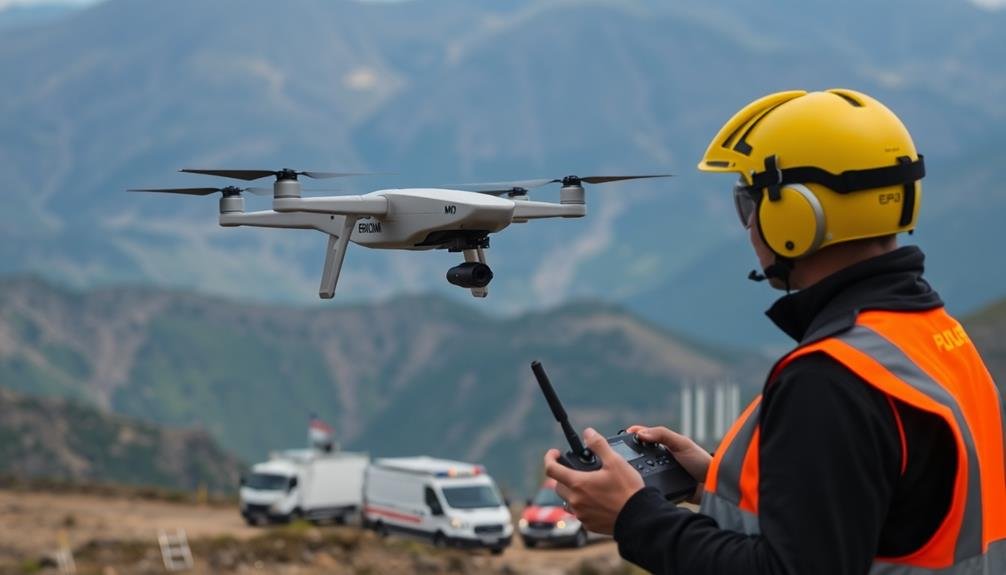
Before launching your UAV for search and rescue missions, you'll need to secure proper airspace authorization.
You must follow specific procedures to obtain permission from relevant authorities, which may include local law enforcement, emergency services, and aviation regulators.
Additionally, guarantee you meet all pilot certification requirements, as operating a drone for search and rescue often demands specialized training and qualifications.
Airspace Authorization Procedures
Obtaining proper airspace authorization is a critical step in conducting UAV search and rescue missions. You'll need to navigate the complex airspace regulations and secure the necessary permissions before launching your UAV.
Start by identifying the airspace classification of your intended operation area and determining if it requires authorization.
For operations in controlled airspace, you'll typically need to request authorization through the FAA's LAANC (Low Altitude Authorization and Notification Capability) system. This automated process allows for near-real-time approval in many cases.
If LAANC isn't available in your area, you'll need to submit a manual request through the FAA's DroneZone portal, which may take longer to process.
In emergency situations, you can request expedited authorization by contacting the local Air Traffic Control facility or the FAA's System Operations Support Center.
Be prepared to provide:
- Detailed mission information
- UAV specifications and capabilities
- Pilot qualifications and certifications
Pilot Certification Requirements
Proper pilot certification is essential for conducting UAV search and rescue missions legally and safely. You'll need to obtain a Remote Pilot Certificate from the FAA by passing the Part 107 knowledge test. This certificate demonstrates your understanding of regulations, operating requirements, and procedures for safely flying small unmanned aircraft systems (sUAS).
To qualify for the Part 107 certificate, you must be at least 16 years old, pass a TSA security background check, and demonstrate aeronautical knowledge. Once certified, you'll need to renew your license every 24 months by passing a recurrent knowledge test.
For search and rescue missions, additional certifications may be required:
| Certification | Purpose | Emotional Impact |
|---|---|---|
| FEMA SAR | Ground operations | Preparedness |
| NIMS ICS | Incident management | Confidence |
| First Aid/CPR | Emergency response | Compassion |
These certifications guarantee you're equipped to handle various aspects of search and rescue operations. Remember, staying current with your certifications and continuously improving your skills will make you a valuable asset to any SAR team. Always prioritize safety and follow regulations to maintain the integrity of your missions.
Assessing Weather Conditions
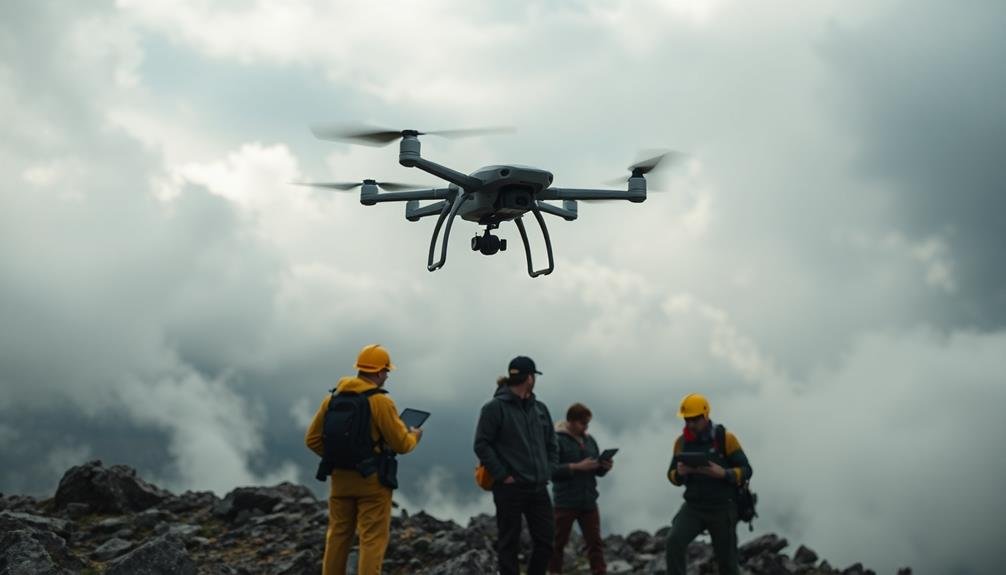
Given the significant nature of UAV search and rescue missions, evaluating weather conditions is paramount.
You'll need to assess various meteorological factors that can impact your drone's performance and the overall success of the operation. Start by checking local weather reports and forecasts for the mission area. Pay close attention to wind speeds, precipitation, temperature, and visibility.
Wind is particularly vital, as it affects your UAV's flight stability and battery life. You should avoid flying in winds exceeding your drone's capabilities, typically around 20-25 mph for most consumer models.
Precipitation can interfere with sensors and cause electrical malfunctions, so it's best to postpone missions during heavy rain or snow. Temperature extremes can affect battery performance and flight time, while poor visibility may hinder your ability to maintain visual line of sight.
Use these tools to assess weather conditions:
- Weather apps or websites with hourly forecasts
- Local aviation weather reports (METARs and TAFs)
- On-site observations using portable weather stations
Mapping Search Areas
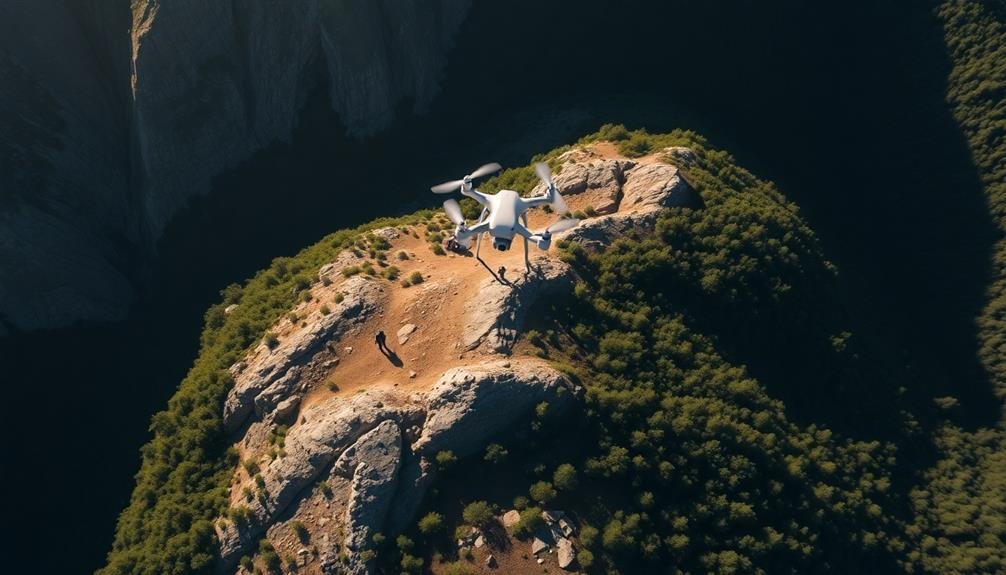
Before launching your UAV, you'll need to carefully map out the search areas. Start by obtaining detailed topographic maps and aerial imagery of the region. Divide the area into manageable sectors based on terrain features, potential hazards, and the last known location of the missing person or object.
Use GPS coordinates to define the boundaries of each sector, ensuring no areas are overlooked. Create a grid pattern within each sector, with flight paths that account for the UAV's battery life and range. Consider factors like elevation changes, vegetation density, and potential obstacles that might affect your drone's performance.
Prioritize sectors based on probability of success, starting with areas closest to the last known location and expanding outward. Mark potential landing zones for emergency situations or battery swaps. Include key landmarks, water sources, and any known structures in your map for reference points.
Utilize mapping software to create digital versions of your search areas, which can be easily shared with team members and updated in real-time. This digital map should include flight paths, waypoints, and areas of interest to guide your UAV operations efficiently and systematically.
Establishing Communication Protocols
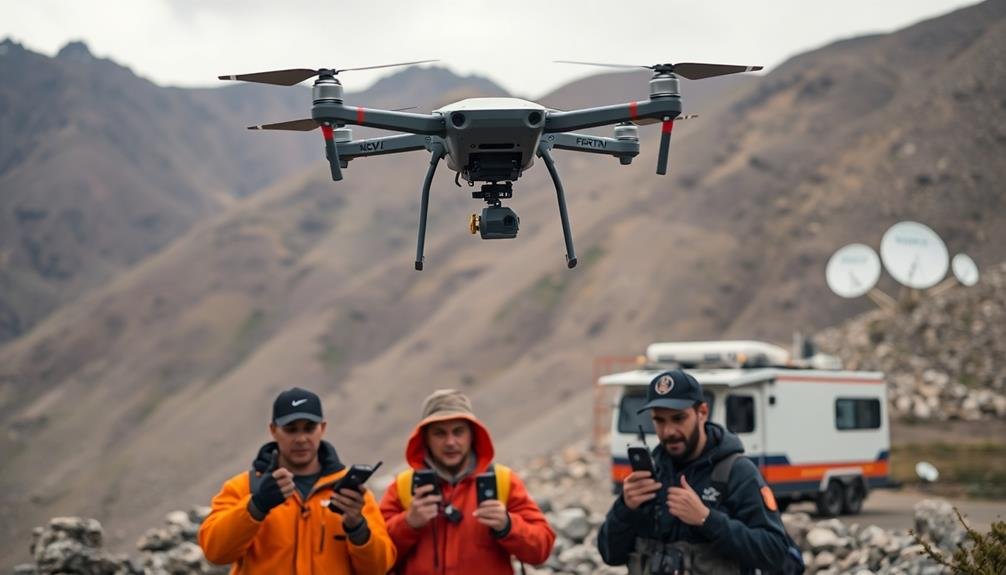
To guarantee effective UAV search and rescue operations, you'll need to establish clear communication protocols.
Designate specific channels for different aspects of the mission, such as separate frequencies for UAV operators, ground teams, and mission control.
Implement standardized command procedures to streamline communication and prevent misunderstandings during critical moments of the search and rescue effort.
Clear Channel Designation
Communication clarity is paramount in UAV search and rescue missions. To guarantee effective coordination, you'll need to designate clear channels for different aspects of the operation. Assign specific frequencies or communication platforms for each team or function involved in the mission. This separation helps prevent confusion and allows for more efficient information flow.
When designating clear channels, consider the following:
- Allocate separate channels for UAV operators, ground teams, and mission control
- Establish a dedicated emergency channel for critical information
- Designate a channel for inter-agency communication if multiple organizations are involved
You'll want to create a communication plan that outlines these channel designations and distribute it to all team members before the mission begins. Make certain that everyone understands which channel to use for specific types of communication and when to switch between channels if necessary.
Test your communication systems thoroughly before deployment to identify any potential issues or interference. Be prepared to adapt your channel designations if unexpected problems arise during the mission.
Clear channel designation is vital for maintaining situational awareness and coordinating efforts effectively throughout the search and rescue operation.
Standardized Command Procedures
Establishing standardized command procedures is essential for effective UAV search and rescue missions. You'll need to implement clear, concise protocols that all team members understand and follow.
Start by creating a chain of command, designating roles for the mission commander, UAV pilot, and ground support team. Develop a set of standard operating procedures (SOPs) that outline step-by-step instructions for various scenarios.
Establish a common language for communication, using clear and unambiguous terms. Implement a system of call signs for team members and assets to streamline radio communication.
Create a standardized format for mission briefings, including mission objectives, area of operation, and safety considerations.
Develop protocols for emergency situations, such as UAV malfunctions or loss of communication. Include procedures for handovers between team members during extended missions.
Implement a system for real-time data sharing between the UAV and ground control station.
Regularly practice these procedures through simulations and drills to guarantee all team members are proficient.
Update and refine your SOPs based on lessons learned from each mission, continuously improving your team's effectiveness and efficiency in UAV search and rescue operations.
Drone Piloting Techniques
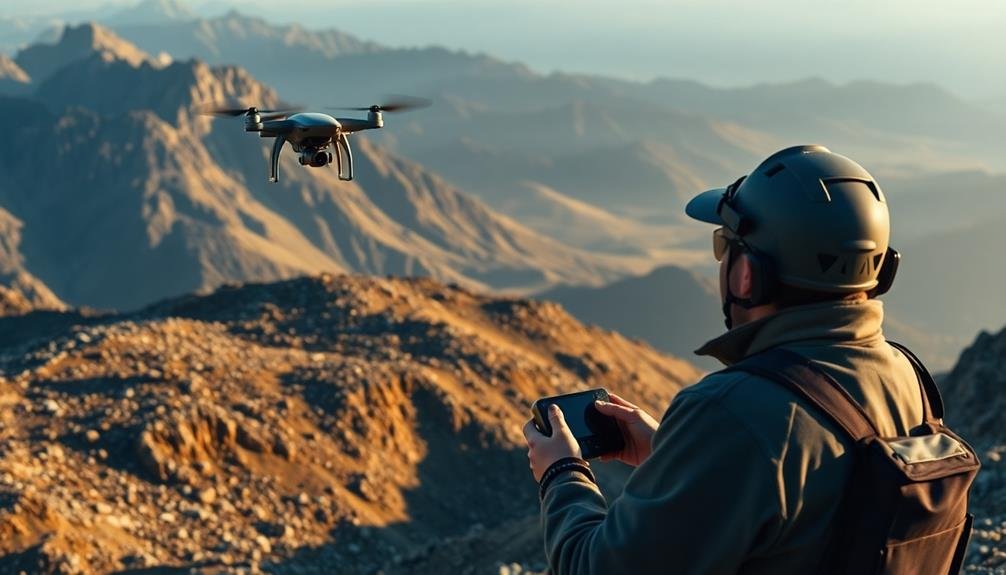
While mastering drone piloting techniques is essential for effective search and rescue missions, it's equally important to understand the specific challenges of SAR operations. You'll need to navigate various terrains, weather conditions, and time constraints while maintaining situational awareness.
To excel in SAR drone piloting, focus on these key techniques:
- Precision flying: Practice maintaining steady altitude and speed, especially in confined spaces or when approaching potential victims.
- Grid search patterns: Master flying in systematic patterns to guarantee thorough coverage of the search area.
- Obstacle avoidance: Develop quick reflexes to maneuver around trees, buildings, and other obstacles without losing sight of your objective.
You'll also need to become proficient in using your drone's camera and sensors effectively.
Learn to switch between different viewing modes, such as thermal imaging and optical zoom, to enhance your ability to spot survivors or evidence.
Don't forget to practice smooth camera movements to capture clear, stable footage that can be easily analyzed by the SAR team.
Image and Video Analysis

After capturing footage during your SAR mission, you'll need to analyze it effectively to identify potential survivors or clues. Use specialized software designed for SAR image analysis to enhance and examine your drone's footage. Look for color contrasts, unusual shapes, or movement that might indicate human presence.
Pay close attention to areas with disturbed vegetation, debris fields, or any signs of recent human activity. Use thermal imaging data to spot heat signatures that could be from survivors, especially in low-visibility conditions or densely forested areas. Apply filters to improve image clarity and highlight specific features.
Train your eye to recognize common distress signals or improvised markers survivors might create. Don't overlook small details; even a tiny reflection or unnatural pattern could be significant. Review your footage multiple times, as fatigue can cause you to miss important clues.
Consider using AI-powered object detection algorithms to assist in identifying potential targets. These tools can help process large amounts of data quickly, flagging areas of interest for human review.
Always cross-reference your findings with other available information and ground team reports to build an all-encompassing picture of the search area.
Thermal Imaging for Detection
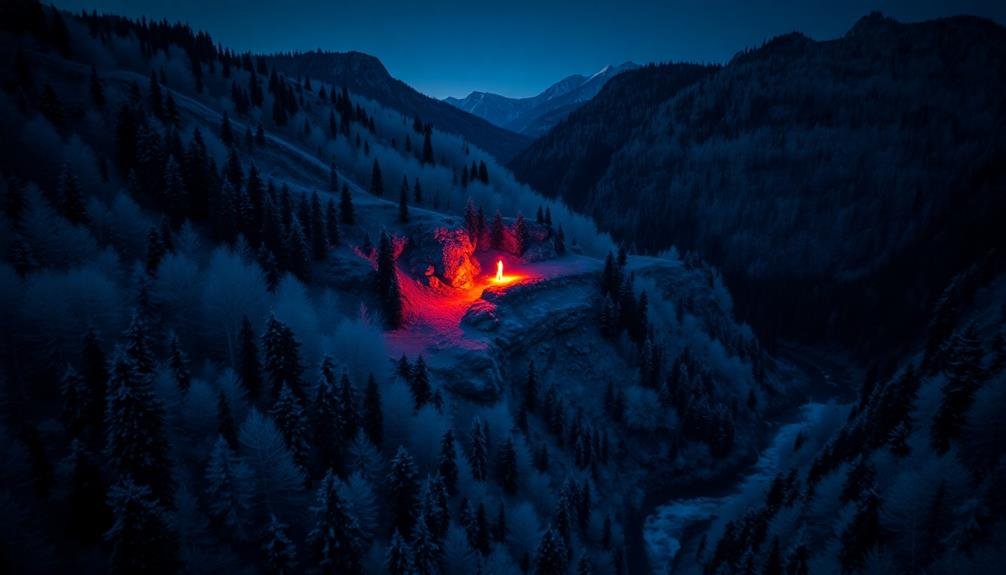
Thermal imaging is a game-changer for SAR drone operations, especially in challenging conditions. It allows you to detect heat signatures of people or animals, even in low visibility situations like darkness, smoke, or dense vegetation.
By equipping your UAV with a thermal camera, you'll considerably enhance your ability to locate missing persons or survivors in disaster areas.
To effectively use thermal imaging in your SAR missions:
- Calibrate your thermal camera before each flight to guarantee accurate temperature readings
- Understand the different color palettes and their interpretations for various scenarios
- Train your team to quickly identify human heat signatures among other warm objects
When scanning an area, fly at a consistent altitude and speed to maintain image quality. Look for heat patterns that resemble human shapes or movement.
Remember that environmental factors like sunlight, reflective surfaces, and temperature variations can affect thermal readings. Always cross-reference thermal data with visual imagery and other sensors for more accurate results.
Thermal imaging isn't foolproof, so use it in conjunction with other search methods. It's particularly effective for nighttime operations, searches in forested areas, and locating people in water.
Coordinating With Ground Teams
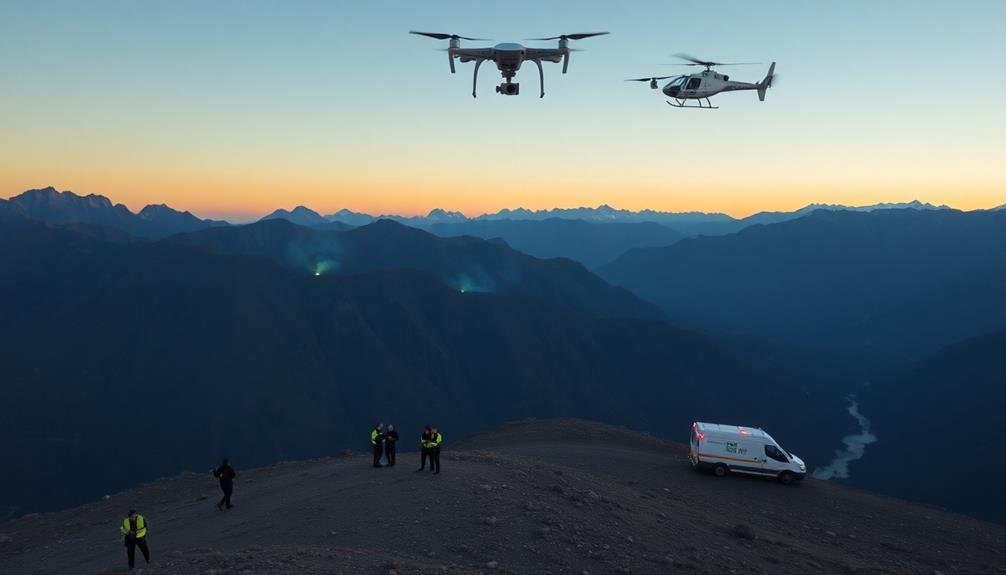
When coordinating UAV operations with ground teams, you'll need to establish clear communication channels first.
You should set up reliable radio or digital communication systems to guarantee real-time information exchange between aerial and ground units.
Define specific roles and responsibilities for both UAV operators and ground searchers to maximize efficiency and prevent overlap or gaps in search coverage.
Establish Clear Communication Channels
Clear communication is the backbone of any successful UAV search and rescue mission. You'll need to establish effective channels between the UAV operator, ground teams, and mission control. Start by setting up a dedicated radio frequency or secure messaging system for real-time updates.
Make sure all team members are familiar with standard communication protocols and terminology to avoid confusion during critical moments. Designate a central point of contact to manage information flow and prevent conflicting instructions. This person should relay UAV findings to ground teams and coordinate their movements accordingly.
You'll also want to establish a clear chain of command for decision-making during the mission.
Consider implementing these communication strategies:
- Use a standardized phonetic alphabet for clarity in voice communications
- Employ visual aids like maps or grid systems for precise location reporting
- Develop a set of pre-defined hand signals for situations where radio communication isn't possible
Remember to conduct regular communication checks throughout the mission to make sure all channels remain operational. If technical issues arise, have backup communication methods ready to deploy.
Define Roles and Responsibilities
Effective coordination between UAV operators and ground teams is the key to a successful search and rescue mission. To guarantee seamless operations, you'll need to clearly define roles and responsibilities for each team member. Start by assigning a mission commander who'll oversee the entire operation and make critical decisions.
Next, designate specific roles for UAV pilots, observers, and data analysts. Pilots should focus on flying the drones, while observers monitor the live feed and communicate potential sightings. Data analysts can process and interpret collected information in real-time.
For ground teams, assign roles such as search coordinators, medical personnel, and communications specialists. Establish a clear chain of command and guarantee everyone understands their specific duties.
| Role | UAV Team | Ground Team |
|---|---|---|
| Leader | UAV Operator | Search Coordinator |
| Support | Observer | Medical Personnel |
| Analysis | Data Analyst | Communications Specialist |
Data Management and Reporting
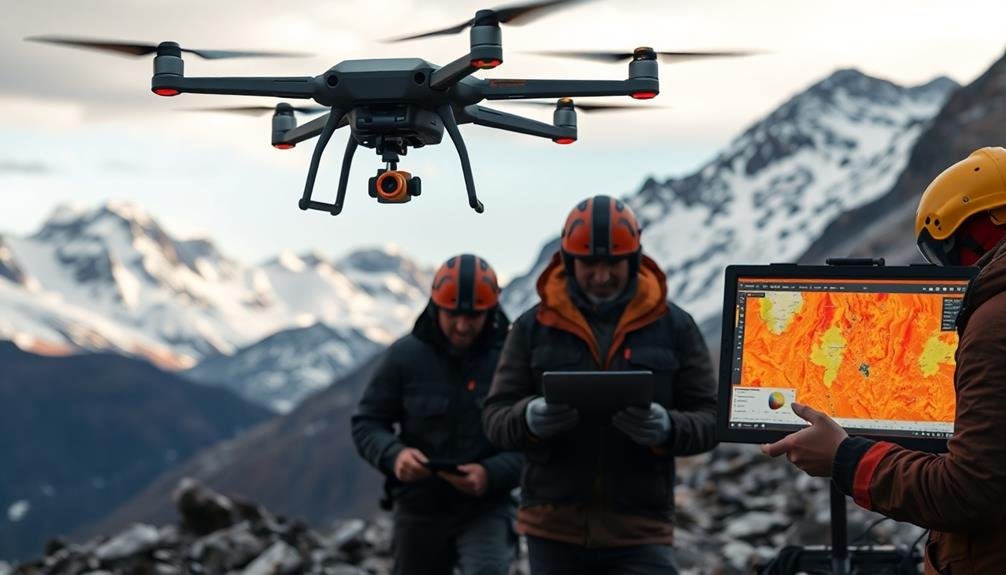
Data management and reporting form the backbone of successful UAV search and rescue missions. You'll need to establish a system for collecting, organizing, and analyzing data from your UAV flights. This includes imagery, video footage, GPS coordinates, and sensor readings.
Implement a standardized format for data storage and guarantee it's easily accessible to all team members.
Create a robust reporting system that allows for quick dissemination of critical information. You'll want to develop templates for mission reports, incident logs, and debriefing documents. These reports should include detailed flight paths, areas covered, findings, and any challenges encountered during the mission.
Consider using specialized software for data management and reporting to streamline your processes. These tools can help you:
- Visualize search patterns and coverage areas
- Track mission progress in real-time
- Generate automated reports for stakeholders
Don't forget to establish protocols for data security and privacy, especially when dealing with sensitive information. Regularly back up your data and guarantee it's stored securely.
Post-Mission Debriefing
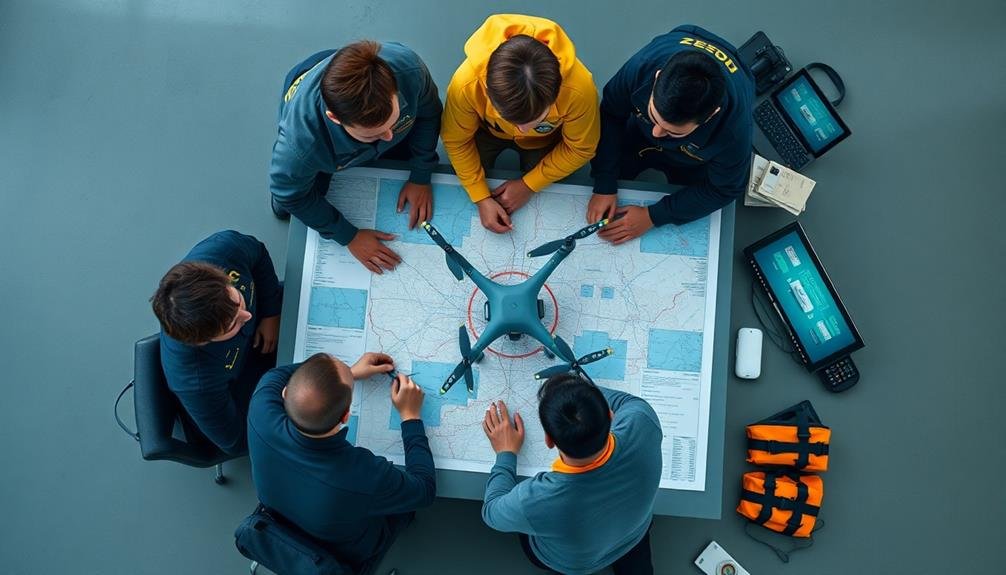
After completing your mission and organizing the data, it's time to gather your team for a thorough post-mission debriefing. This vital step helps improve future operations and guarantees everyone's on the same page.
Start by reviewing the mission objectives and discussing whether they were met. Encourage team members to share their perspectives on what went well and what challenges they faced.
Address any equipment issues, communication breakdowns, or procedural hiccups that occurred during the mission.
Analyze the effectiveness of your search patterns and UAV deployment strategies. Discuss how well the data collected served the mission's goals and if any adjustments are needed for future operations.
Don't forget to evaluate the team's coordination with ground personnel and other agencies involved.
Highlight individual and team achievements, but also identify areas for improvement. Use this opportunity to update standard operating procedures based on lessons learned.
Maintenance and Equipment Care
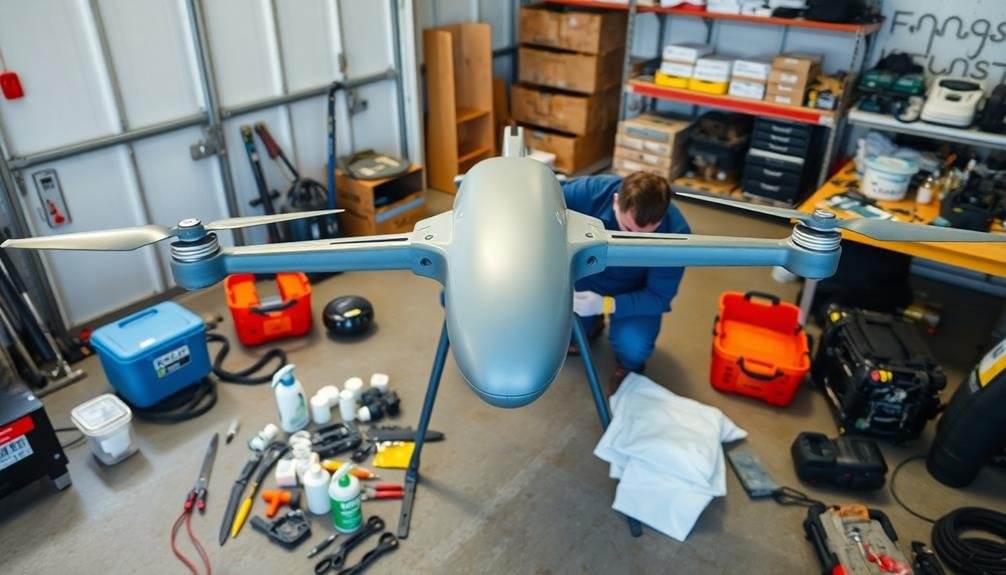
Proper maintenance and equipment care are essential for guaranteeing your UAV's longevity and reliability during search and rescue missions.
After each operation, thoroughly clean your drone, removing any dirt, dust, or debris that may have accumulated during flight. Inspect all components, including propellers, motors, and batteries, for signs of wear or damage. Replace any parts that show excessive wear to prevent in-flight failures.
Regularly update your UAV's firmware and software to guarantee peak performance and access to the latest features. Keep a detailed maintenance log, recording flight hours, repairs, and part replacements. This information will help you track your drone's condition and anticipate when preventive maintenance is needed.
Store your UAV and its accessories in a clean, dry environment when not in use. Use appropriate cases or bags to protect the equipment during transport. Don't forget to maintain your ground control station and other supporting equipment as well.
- Clean and inspect after each mission
- Update firmware and software regularly
- Store properly and protect during transport
Frequently Asked Questions
How Long Does It Take to Become a Certified UAV Search and Rescue Operator?
You'll need about 40-80 hours of training to become a certified UAV search and rescue operator. This includes classroom instruction, flight practice, and passing written and practical exams. Certification time varies based on your experience level.
What Are the Psychological Impacts on Operators During Challenging Search Missions?
You'll likely experience stress, anxiety, and emotional strain during difficult searches. You may feel frustration or helplessness if missions are unsuccessful. It's important to practice self-care and seek support to manage these psychological impacts effectively.
How Do UAVS Integrate With Other Technologies Like Satellite Imagery in SAR Operations?
You'll find UAVs integrate seamlessly with satellite imagery in SAR ops. They complement each other, with drones providing real-time, close-up views while satellites offer wider coverage. You can overlay drone footage onto satellite maps for extensive situational awareness.
What Insurance Considerations Are Necessary for UAV Search and Rescue Operations?
You'll need liability insurance to cover potential damage or injuries. Consider hull coverage for your UAV. Operator insurance protects against errors. Don't forget specialized SAR coverage. Check local regulations, as requirements vary by location.
How Do Cultural Sensitivities Affect UAV Usage in International Search and Rescue Missions?
You'll need to contemplate local cultural norms when using UAVs internationally. They may be seen as intrusive or disrespectful in some areas. Always seek permission and explain your mission's purpose to avoid misunderstandings or conflicts.
In Summary
You've now learned the key aspects of conducting UAV search and rescue missions. Remember to prioritize safety, follow regulations, and maintain open communication with your team. Stay current with technology and best practices, and always debrief after missions to improve your skills. With proper planning, execution, and post-mission analysis, you'll become an invaluable asset in saving lives and supporting rescue efforts using UAV technology.

As educators and advocates for responsible drone use, we’re committed to sharing our knowledge and expertise with aspiring aerial photographers.
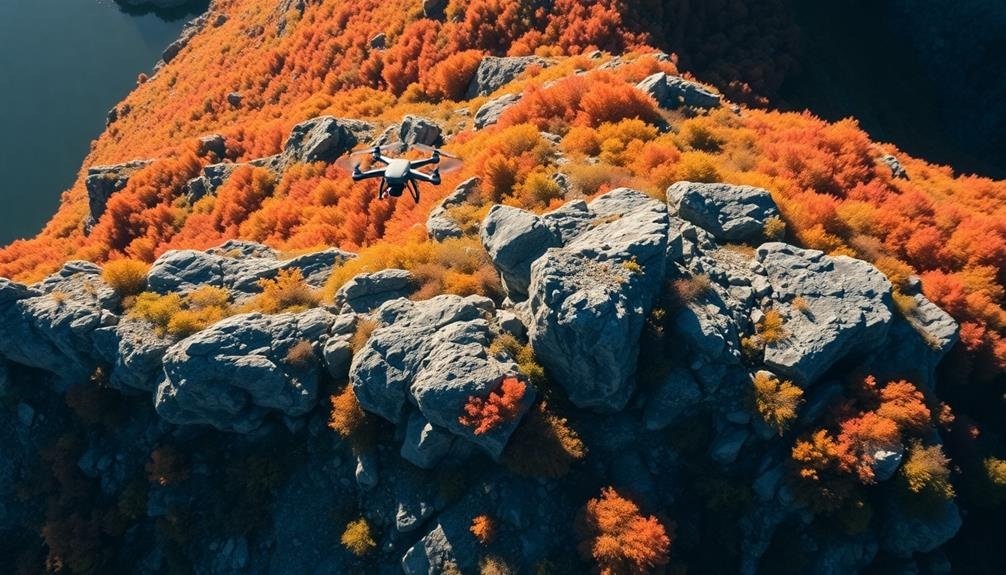



Leave a Reply